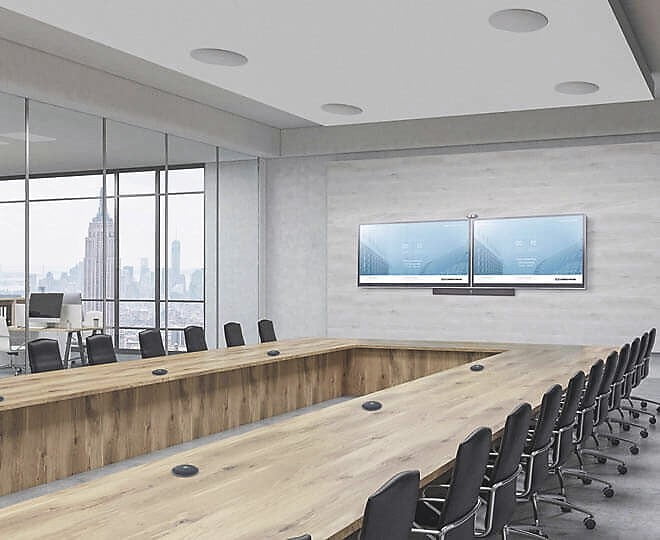What drives the technology in your meeting room? “Which screen type is better for my meeting room, an LED display or a projection system?” It’s one of the first questions we’re asked when approaching a collaborative room project however, to achieve the best outcome it’s important to keep in mind that technology does not drive the best application but instead, the use and goals of the space will drive the technology. While ease of installation, price and total cost of ownership (TCO) are factors, the answer depends on the project’s goals and on the calculated proper screen size. Once the size is determined and the client and AV Designer have a clear understanding of the goals to be achieved, the type of display best suited for the application can be revealed. Let’s take at look at what each has to offer. Flat Screens The main flat Screen display technologies are Plasma, LED, and OLED (organic light-emitting diode), with the most widely accepted being the LED LCD display. Plasma, still in use in a consumer “niche” market by video purists who believe it provides the truest contrast and color saturation, is no longer used in commercial applications. As 4K continues to become more prevalent however, plasma will be going the way of the VCR. OLED, dating to 1987 was developed by researchers at Eastman Kodak, is the next great technology sweeping the flat screen market and will likely become the next standard. It may be a short-lived victory however as manufacturers are already looking ahead to direct view micro-LED technology as the next “big thing.” Although similar in name to OLED, QLED technology is dramatically different. QLED is essentially an LED TV that uses quantum dots to enhance key picture quality areas and boasts of creating deeper black levels and reproducing more colors than ordinary LEDs. LED Direct View technology is rapidly evolving. Originally making a splash on the likes of NY’s Times Square, over the past few years manufacturers have been able to provide smaller “pixel pitch” (ppx) panels that provide finer, more detailed picture quality. These units are ideal for close viewing, making them a great choice for retail signage, auditoriums and Emergency Operations Centers or Network Operations Centers (EOC/NOC’s). LED Direct view is also perfect for spaces affected by uncontrolled ambient light. As the price continues to settle and the pixel pitch technology becomes smaller (Micro-LED), we will see more direct view applications in board rooms and smaller spaces. As shared in Part 1, there are guidelines and formulas for determining the proper viewing screen size in a conference room. Those best practices hold true for 4K displays/projection screens as well but, with the incredible resolution of a 4K display or projector, you’ll need to consider that 4 times the amount of pixels will be displayed (imagine duplicating that screen into a 2×2 grid on the viewing surface). What does that mean for your image? While the resolution is incredibly true and sharp, font size and detailed content such as spreadsheets, will need to be enlarged. Projection Systems There are three main types of projection systems in use: traditional lamp (HID, high-intensity discharge lamps) DLP, LCD projectors and the new laser projectors (laser phosphorous projectors). Laser projectors are quickly gaining momentum in the industry because of their picture quality, long-life lamps and energy efficiencies. A laser projector can run 20,000 hours before displaying a noticeable degradation of light output, whereas a HID lamped unit’s degradation may be detected as early as 1500 hours. HID lamp changes are usually made every 2,000 to 3,000 hours so, despite the added initial cost of laser (approximately 30% over that of HID), it yields a lower TCO. LED lighted technology is still available, but its lower lumens are more appropriate for home theater than a bright office environment. Flat screen or projection – which is best for your meeting room? Just give us a call. We’ll uncover the right solution to make your meetings effective and productive.


